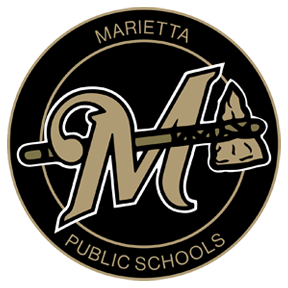Although conflicting research regarding the COVID pandemic is common, data regarding the effect on education agrees: students experienced a significant learning losses in the pandemic – approximately one-half a year in math and one-third of a year in reading. The deficit is blamed on school closures, but just being back in school has not corrected it.
Like most schools post-COVID, Marietta Public Schools’ student academic progress has struggled to rebound, so this year, the district has invested in teacher training and coaching on Professional Learning Communities.
“We have so many talented and phenomenal teachers who are continuing to see COVID-related learning deficits, and they’re frustrated that students seem to be falling further behind,” said Superintendent Brandi Naylor. “It was time to give our teachers the resources and time to create a system that can have lasting impact on our students.”
PLCs are not new to education. They’re a proven approach to creating and using a systematic plan, that, when implemented with fidelity and consistency, is shown to improve not only student academic achievement, but the culture of the school district.
Although some of the district’s administration had previously received PLC training, other members of the administrative team attended training last summer, returning enthused and excited to see how positive the outcome could be. The district then brought in a coach to train administration and certified staff for implementation of PLCs.
PLCs shift the focus of education from teaching to learning and are based on core principles that ask three questions: What do we want students to learn? How will we know they have learned it? What will we do when a student struggles to learn what they should?
Collaboration is key as educators align curriculum so that a system of building steps is in place from unit to unit, standard to standard, or level to level. Teachers were teamed up by grade level or departments and tasked to examine state standards and identify those that are essential before moving to the next grade level or subject area. That task completed, the teams are developing assessments for each standard or skill.
“If students do not perform well on these assessments, we provide immediate interventions to struggling students and enrichment to students who have mastered the concept,” said Naylor.
This process is repeated as students move through skills, standards, and subject areas. Although PLCs are research-based and proven by time, adoption is not free of frustration.
“Anytime you make major changes, some teachers have difficulty getting on board,” Naylor remarked. “Change is hard, and we know we’ve asked a lot of our teachers, but we can’t keep doing the same things that aren’t working and expecting different results.
“A few teachers are still unhappy, but we’ve also had many teachers step up and become absolute rock stars throughout the process. Some of the teachers who were the most apprehensive have taken the reins and become true leaders in our district.”
Ailey Self, an elementary teacher, sees value in the program, including a better understanding of what needs to be taught. She already sees a difference in the confidence of her students.
“Going through the process has made me a better teacher for my students,” she said. “While the process has been challenging from time to time, I appreciate our school investing in PLCs to ensure student mastery of standards we are teaching.”
MPS educator Amy Miller is also a fan of the learning communities. She enjoys the collaboration with other teachers, both veterans with years of experience and those who are just getting started.
“PLCs give veteran teachers new perspectives while providing resources and guidance to new teachers. It’s a time to share resources, materials, strategies, and other tricks of the trade,” remarked Miller. “PLCs provide all teachers with a sounding board to decide where our focus should be within the grade level standards to provide the best education for our students."
Research shows that academic turnaround is a slow process – one that could take up to five years, but the school is already seeing gains in the first year.
“Our district has several extracurricular programs that we are proud of, but academics is what we are here for. Students’ academic success spills over into all areas of the community,” Naylor reminded. “When students perform better academically, they are better in every area and become more successful adults and community members. No matter the effort it takes, our kids are worth it.”
